
JDBC Type 3 Driver: Features, Usage, Advantages & Disadvantages
The JDBC Type 3 Driver, also known as the Network Protocol Driver, is a crucial part of Java Database Connectivity (JDBC) that facilitates communication between Java applications and databases. Unlike other drivers, the Type 3 Driver uses a middleware server to translate JDBC calls into database-specific protocol, making it a flexible and scalable option for enterprise applications.
In this article, we’ll explore the architecture, features, advantages, disadvantages, and common use cases of the JDBC Type 3 Driver to help you understand its role in database connectivity.
What is a JDBC Type 3 Driver?
The JDBC Type 3 Driver is a middleware-based driver that works as an intermediary between Java applications and databases. It translates JDBC method calls into a database-independent protocol and forwards them to the middleware server. The middleware server then converts these requests into a database-specific protocol and communicates with the database.
This architecture makes the Type 3 Driver suitable for distributed applications, where multiple databases and platforms need to be accessed seamlessly.
How JDBC Type 3 Driver Works
The Type 3 Driver involves the following steps:
- Java Application: The application makes a database request using standard JDBC API calls.
- Type 3 Driver: The driver translates the JDBC calls into a generic database protocol.
- Middleware Server: The middleware server receives the protocol, converts it into a database-specific protocol, and forwards the request to the database.
- Database: The database processes the request and sends the results back through the middleware server to the application.
Key Features of JDBC Type 3 Driver
- Middleware-Based: Requires a middleware server to handle database-specific protocol conversions.
- Database Independence: Supports multiple databases without requiring database-specific drivers on the client side.
- Network-Based: Communicates over the network, making it ideal for distributed systems.
- Centralized Management: The middleware server centralizes database connections, improving maintainability.
- Flexible Deployment: Works well in environments with heterogeneous databases and platforms.
Advantages of JDBC Type 3 Driver
- Platform Independence: The middleware server eliminates the need for database-specific drivers on client machines.
- Centralized Configuration: Database connections are managed centrally, simplifying updates and configuration changes.
- Scalability: Supports large-scale distributed systems by handling multiple databases efficiently.
- Multiple Database Support: Works with various databases through a single driver, reducing complexity.
- Lightweight Clients: The client-side setup is minimal, as the middleware server handles most of the processing.
Disadvantages of JDBC Type 3 Driver
- Middleware Dependency: Requires a dedicated middleware server, which can increase system complexity and cost.
- Performance Overhead: Additional network hops between the application, middleware, and database can introduce latency.
- Maintenance: The middleware server must be maintained and updated, adding to operational overhead.
- Limited Use Cases: Not suitable for standalone applications due to its reliance on network connectivity.
Use Cases of JDBC Type 3 Driver
- Enterprise Applications: Ideal for large-scale systems with multiple databases and distributed architecture.
- Heterogeneous Environments: Suitable for applications that need to interact with different types of databases.
- Cloud-Based Systems: Works well in cloud environments where centralized management is essential.
- Migration Projects: Helps in migrating applications to new databases by providing a uniform interface.
JDBC Type 3 Driver vs Other JDBC Drivers
| Feature | Type 1 Driver | Type 2 Driver | Type 3 Driver | Type 4 Driver |
|---|---|---|---|---|
| Middleware Requirement | No | No | Yes | No |
| Database Independence | Partial | Limited | High | Limited |
| Performance | Low | Moderate | Moderate | High |
| Client-Side Setup | Complex | Complex | Lightweight | Simple |
| Use Case | Small Applications | Native Systems | Distributed Systems | Standalone Systems |
Example of JDBC Type 3 Driver Usage
Here’s an example of using a JDBC Type 3 Driver in a Java application:
Best Practices for Using JDBC Type 3 Driver
- Optimize Middleware: Ensure the middleware server is optimized for handling large-scale requests efficiently.
- Monitor Network Latency: Regularly check for network delays and optimize routing for better performance.
- Use Connection Pooling: Reduce the overhead of establishing connections by using a connection pool.
- Secure Connections: Implement encryption for secure communication between the application, middleware, and database.
Summary
The JDBC Type 3 Driver is an excellent choice for enterprise applications requiring centralized database management and support for distributed systems. While it has some performance overhead due to middleware dependency, its flexibility and scalability make it ideal for complex environments with multiple databases.
By understanding its architecture, advantages, and use cases, developers can effectively leverage the Type 3 Driver for building robust and scalable Java applications.